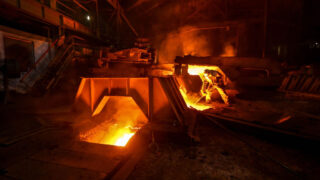Market signals needed
The world’s most successful environmental treaty was adopted in the late 1980s, with a push from two leading lights of the conservative movement: British Prime Minister Margaret Thatcher and American President Ronald Reagan. Both were instinctively suspicious of the United Nations and its attempts to make international law. Mrs Thatcher, however, was also an Oxford University-educated chemist who understood the scientific finding that certain industrial substances were destroying the layer of ozone gas high in the atmosphere. That layer protects the Earth’s surface from deadly levels of ultraviolet radiation.
Worldwide alarm led to the push for a treaty to control those substances. Mrs Thatcher supported the goal, and she persuaded Mr Reagan to overrule his advisers and support it. With the American and British governments playing constructive roles in the UN negotiations, the Montreal Protocol on Substances that Deplete the Ozone Layer went into force in 1989. As a result, ozone-depleting gases in the atmosphere are falling and the ozone layer is recovering.1 Some of the destructive substances are also strong greenhouse gases, so the protocol — after nine revisions to add new rules — is also helping to limit global warming. It was the first treaty in history to achieve universal ratification, standing as a shining example of what is possible in protecting the environment.
A walk in the woods

President Ronald Reagan with Prime Minister Margaret Thatcher at Camp David, in Maryland, in 1986, the period when the Montreal Protocol was being negotiated.
Source: Wiki Commons
Now, the countries of the world are trying to negotiate a new treaty, with the Montreal Protocol as a model. The goal is to protect the world from the rising tide of plastic pollution. Negotiations have entered a feverish stage, and are due to conclude late this year in Busan, South Korea, though the possibility of delay cannot be ruled out. A weak outcome would be a treaty that merely takes some steps to improve the dismal rates of plastic recycling and discourages the most wasteful single-use plastic products. A strong treaty would be one that follows the example of the Montreal Protocol, setting explicit limits on what kinds of plastic can be produced, in what quantities. It would require that only genuinely recyclable plastics be created, and would contain strong measures to encourage the development of a ‘circular economy’ in which plastics are never discarded into the environment or burned.
Without such limits, some analysts warn that the production of plastic could nearly triple by 2060.2 Plastics — in visible chunks or as ‘microplastics’ too small to see — already litter the depths of the ocean, the tops of the highest mountains and everywhere in between. Microplastics contaminate the food supply as well as human bodies, and have been found lodged in people’s brain tissue.3 Whether they are causing damage to human health is an area of active research, though it is clear that plastics represent a threat to wildlife. The great Pacific Ocean garbage patch has become a symbol of humanity’s woeful stewardship of the environment.
The plastic threat

A black-footed albatross chick with plastics in its stomach lies dead on Midway Atoll in the Pacific Ocean.
Source: The Syndicate/Alamy
Something like 400 million tonnes of plastic is produced every year.4 The main feedstocks used to create it are oil and certain liquids associated with the production of fossil gas. The fossil-fuel industry thus sees the plastics treaty as a threat to a major and growing part of its business, and is attempting to torpedo the global negotiations. The American government was kowtowing to these interests until recently, but as this report was going to press, announced that it would switch gears and support firm limits on plastic production.5 Some other governments are still obeisant to the fossil-fuel interests, however, and the outcome of the negotiations is far from certain. Rwanda and Norway are leading a coalition of 65 countries and the European Union in seeking a strong treaty.
We are hoping for a bold outcome in the negotiations, and not just because the world needs to get control of plastic pollution. If we can prove that the Montreal Protocol was not a one-off — that limits on the production of problematic substances can be written into international law — then the prospects improve for other agreements that could help to bring down greenhouse gas pollution from the world’s industries.
Industry is responsible for 34 percent of the excess carbon dioxide entering the atmosphere, making it the largest emitter of the sectors we analyse.6 Plastic accounts for about 3 percentage points of that total; plastic is arguably more important as a source of litter than as a source of greenhouse gases. Production of steel7 and cement8 each accounts for at least 25 percent more greenhouse gas pollution than does the plastics industry.
Overall, the world’s factories and mines constitute one of the most problematic sectors, with clean production methods still in their infancy for many industries. The International Energy Agency reckons that industrial emissions need to begin falling between now and 2030 if we are to stand a chance of meeting the most ambitious goal of the Paris Agreement: limiting global warming to 1.5 degrees Celsius above pre-industrial levels. But so far, those emissions are not falling. They have been essentially flat for five years, and may start rising again as the Chinese economy recovers from its recent downturn. New steel plants, new cement plants and new chemical factories are under construction or on the drawing board all over the world, with few of them expected to use low-emissions technologies.
Figure 35: From the smokestack
This chart shows historical emissions from industry on the left, and in the shaded area at right, the steep decline required to meet global climate goals. There is no sign so far that industries are preparing to cut their emissions as rapidly as required.
Source: BloombergNEF
The biggest problem is that demand in the marketplace for cleaner production has yet to emerge in a significant way. Many of the biggest emitters are producing commodities like cement and steel at low margins, and are extremely sensitive to higher costs. Ultimately, public standards are the only way out of this conundrum: rules that require a rising percentage of clean steel or cement, for example, would level the playing field and give industries the incentive to invest in new methods. That would ultimately bring costs down, but it would take time.
Making steel

Most mills producing virgin steel use fossil fuels and emit prodigious quantities of greenhouse gases. Here, a worker performs his duties at a steel mill in Ukraine.
Source: Ukrinform/NurPhoto via Getty Images
Fortunately, we are beginning to see early signs of such marketplace demand for cleaner methods. A coalition of European companies recently announced, for instance, that they would buy ‘green’ steel and pay a premium for it. Emissions from steel production can be cut sharply by replacing fossil fuels in a furnace with hydrogen; the hydrogen must be made using renewable electricity. The resulting product is known as green steel. A Generation subsidiary, Just Climate, and its clients invested in one of the first such plants, H2 Green Steel in Sweden, a few years ago. (As this report was going to press, the company changed its name to Stegra.) Just within the past 18 months, the number of such plants on the drawing board has tripled, from two to six.9 At the moment, green steel is costlier to make: the initial premium over regular steel is expected to be in the order of 25 percent, and the companies willing to pay it include manufacturers of wind turbines and of electric cars.
Green hydrogen, produced by using renewable electricity to split water molecules with no resulting greenhouse emissions, will be a critical input for the first green steel plants. An abundant supply of green hydrogen would also be a boon for the chemicals industry, a prodigious source of emissions. It could help to clean up plastics production. It could be used to completely decarbonise the production of ammonia, a fertiliser critical to the world food supply.
Two things will be vital for producing abundant green hydrogen: a piece of kit called an electrolyser, and plentiful clean electricity. Electrolysers use power to split water into hydrogen and oxygen, and they will need to be deployed in the tens of millions to make a real dent in industrial emissions. Fortunately, electrolyser manufacturing is beginning to scale, and costs are falling.
Figure 36: Split those molecules
This chart shows shipments of electrolysers capable of making hydrogen by splitting water molecules, measured by megawatts of electrical input.
Source: IEA
You might have supposed, from all the hype around green hydrogen in recent years, that a vast surfeit of it must be on the way. Unfortunately, this is not the case, as the hype sped ahead of reality. Green hydrogen is still three to four times more expensive than dirty hydrogen produced from fossil gas,10 and that cost can only be brought down by scaling the market — which means somebody has to ‘overpay’ for the first projects using green hydrogen.
This is the kind of problem classically solved by government intervention to subsidise early developments and create demand, but in this instance, as in others, governments have talked a bigger game than they have played. Many hundreds of green hydrogen projects are on the drawing boards of hopeful developers, but few of them are proceeding to final investment, with financiers worried about the lack of a market for such a costly product. Some projects, announced with great enthusiasm only a few years ago, have already been cancelled.11 The city of Hanover in Germany figures it is out of pocket €10 million of taxpayers’ money on a failed project.12
It is true, however, that subsidies are finally beginning to flow from governments in Europe, Japan and the United States to develop the market for green hydrogen. The United States government in 2023 awarded $7 billion in grants for seven ‘hydrogen hubs’ spanning the country, and some of these are already under construction. Japan is keenly interested in developing an international market for trading clean hydrogen or its derivative, ammonia, by ship. Within a few years, we should begin to get an idea of how fast the costs can come down. China is making a big push to cut the cost of electrolysers and is already selling them more cheaply than other countries, though the quality of the Chinese equipment has been questioned. If China can solve that, it might end up owning a large share of the equipment market, as it has done for other green industries.
In the cement industry, emissions are basically static, not falling at the brisk clip necessary to achieve climate goals. Cement is a special case, because the emissions come not primarily from burning fossil fuels; they are an inherent part of the chemical process of turning limestone into ‘clinker’ — the binder that is the critical ingredient in cement. The chemical transformation throws off carbon dioxide as a waste product. Methods to lower the carbon footprint of cement are under development, but would drive up costs in a low-margin industry, so they have not been widely embraced.
Figure 37: Cement emissions
This chart shows global emissions from cement production since 1920.
Source: Global Carbon Budget
Tentative change is occurring as governments impose emissions standards for the cement they buy to build roads and bridges; such civil engineering projects can be half the cement market in some countries. These governments are sending a market signal that is inducing cement-makers to look closely at their options, and a few clean-cement projects are moving forward. But we are not likely to make fast progress until that market signal becomes much stronger, with most or all buyers of cement demanding a low-emissions product.
Though change is not happening fast enough, we are beginning to see the development of the kinds of public policies that could ultimately transform whole industries. The European Union, for instance, has just put into effect an instrument called a carbon border adjustment mechanism. As of 2024, importers of several high-emissions industrial products, including cement and steel, are having to report the emissions created by their products. Beginning in 2026, the EU will levy tariffs on these products designed to reflect their emissions intensity. Producers within the EU already face emissions taxes, so the idea in the short term is to create a marketplace in which importers do not enjoy an unfair advantage over domestic producers.
The long-term goal, of course, is to encourage all countries wishing to export their goods to the EU to adopt emissions taxes or other strong policies to clean up their economies. Wider adoption of carbon border taxes by countries beyond the EU could have a dramatic effect in encouraging cleaner production worldwide.
- 1. World Meteorological Organization, 2022: “Executive Summary, Scientific Assessment of Ozone Depletion, GAW Report No. 278.” Geneva. Back to inline
- 2. Organisation for Economic Cooperation and Development, 2022: “Global Plastics Outlook: Policy Scenarios to 2060,” p. 26. OECD Publishing, Paris. Back to inline
- 3. Main, Douglas, 21 August 2024: “Microplastics Are Infiltrating Brain Tissue, Studies Show: ‘There’s Nowhere Left Untouched.’” The Guardian. Back to inline
- 4. “Plastics — The Fast Facts 2023.” Plastics Europe, 2023. Back to inline
- 5. Winters, Joseph, 16 August 2024: “The US Says it Now Supports a More Ambitious Plastics Treaty. Industry Groups are Furious.” Grist. Back to inline
- 6. Dhakal, Minx and Toth et al: “Emissions Trends and Drivers,” in“Mitigation of Climate Change. Contribution of Working Group III to the Sixth Assessment Report of the Intergovernmental Panel on Climate Change.” Cambridge University Press, Cambridge, UK and New York, NY, USA: p. 237. Back to inline
- 7. International Energy Agency, 2020: “Iron and Steel Technology Roadmap.” Paris. The figure in the original source has been amended to use total global emissions, rather than energy-only emissions, as the denominator. Back to inline
- 8. International Energy Agency, 2023: “Tracking Cement,” in “Tracking Clean Energy Progress 2023.” Paris. The figure in the original source has been amended to use total global emissions, rather than energy-only emissions, as the denominator. Back to inline
- 9. LeadIT, 2024: “Green Steel Tracker.” Leadership Group for Industry Transition. Back to inline
- 10. International Energy Agency, 2023: “Global Hydrogen Review 2023.” Paris. Back to inline
- 11. The landscape is already littered with scrapped projects, unfortunately. See Memija, Adnan, 4 March 2024: “SSE, Equinor Ditch Green Hydrogen Plans for Dogger Bank D Offshore Wind Farm.” Offshore Wind. See also Memija, Adnan, 14 March 2024: “Vattenfall Scraps Hydrogen Turbine Pilot Project.” Offshore Energy. And see Martin, Polly, 2 February 2024: “Government-Backed Green Hydrogen-to-Methanol Pilot in Belgium Scrapped Due to Escalating Costs.” Hydrogen Insight. Back to inline
- 12. Parkes, Rachel, 14 August 2024: “No Firm Customers; Failed Hydrogen Project Leaves €10m Hole in City’s Accounts Amid Spiralling Costs.” Hydrogen Insight. Back to inline